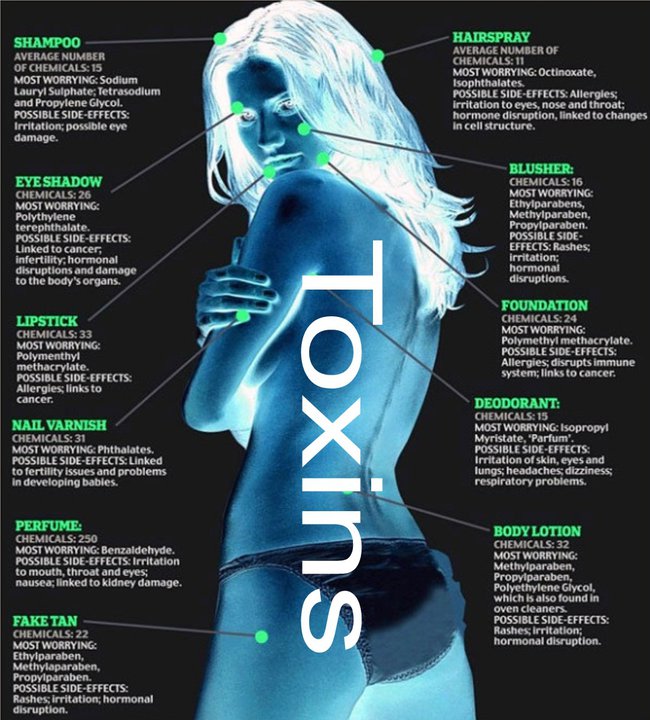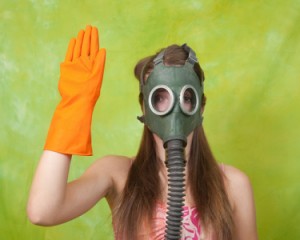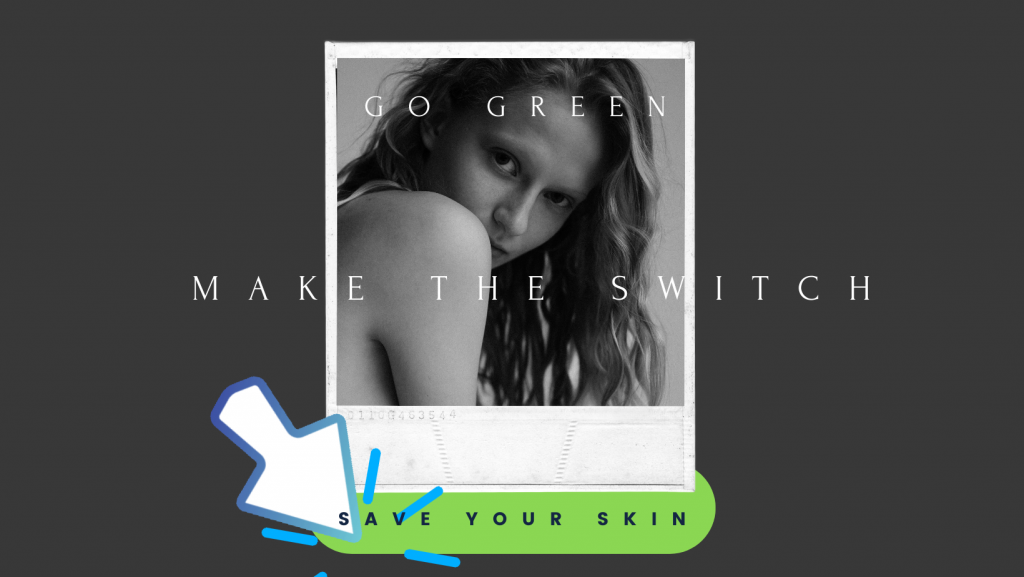Toxins Found In Personal Care Products

Before I share this list of dangerous and deadly toxins in personal care products like shampoo, conditioner, toothpaste, cosmetics, lotion, & more, I want to make sure everyone reading realizes the words natural, pure, organic, botanical, herbal, etc. mean NOTHING in the personal care industry.
Leaded Lipstick: The average lipstick contains 29 different toxins & women ingest 9 pounds of lipstick in their lifetime!
I learned this after buying Tom’s of Maine toothpaste and deodorant without reading the ingredients. I just trusted the label and was willing to pay more for “natural” & what I thought meant safe, toxin-free, products.
As a concerned consumer, I started researching companies that claimed to make safe personal care products. What they put in their products was no different than the toxic ones. The only thing that changed was the price!
FACT: We are smothering ourselves, our children & our environment with a chemical cocktail, scientifically proven to cause neurological & endocrine disruption, cancer, degenerative disease and more!
Worst Toxins In Personal Care Products:
 Women have four times the toxins as men because we have about 10% more body fat than men & store more fat-soluble toxic materials. The toxins in personal care products have been linked to breast cancer and hormone disruption. Women transfer toxins to children in utero and through breast milk, which some researchers suggest can affect fetal development and childhood growth. Ref: Women’s Foundation of California
Women have four times the toxins as men because we have about 10% more body fat than men & store more fat-soluble toxic materials. The toxins in personal care products have been linked to breast cancer and hormone disruption. Women transfer toxins to children in utero and through breast milk, which some researchers suggest can affect fetal development and childhood growth. Ref: Women’s Foundation of California
Toxins In Personal Care Products:
- Sodium Lauryl Sulfate (SLS) & Laureth(SLES): used in shampoo, soap, toothpaste, facial cleansers, car washes, garage floor cleaners & engine degreasers and in 90% of products that foam. SLS (sodium laurylsulfate) acts as a detergent. Used in the laboratory as a membrane destabilizer & solubilized of proteins and lipids, causing potential harm to skin and eyes. Young eyes may not develop properly if exposed to SLS because proteins are denatured. Recent studies have shown a link between the use of toothpaste containing SLS and the occurrence of RAS (canker sores). References 1. Herlofson, Benteand Pal BarkvolSodium lauryl sulfate and recurrent aphthousulcers 1994;52:257-259 2. 1996; 54(3): 150-153
- PROPYLENE GLYCOL: used in cosmetics, hair care, food, deodorant, industrial and RV antifreeze, brake fluid, concrete additive, tobacco products. Many deodorant formulations contain a higher amount of propylene glycol than industrial applications (Tom’s of Maine is one of them). Topical application to injured skin or intravenous administration has sometimes been associated with Lactic acidosis, Comas, Seizures & Renal Failure. Linked to: Central Nervous System Effects, Metabolic Effects & Poisoning. Ref: ATSDR Agency for Toxic Substances and Disease Registry Ref: Reprotext2004
 PARABENS: (Mehtyl, Isobutyl, Ethyl-, Butyl-, Propyl-): used in hair care, lotions, creams, cosmetics, deodorants and soaps. Also used in pet care and food additives. Parabens can mimic the hormone estrogen, which is known to play a role in the development of breast cancers. These preservatives have been shown to cause skin rashes, eye irritation, respiratory irritation, and are very harmful if swallowed. (Published in the Journal of Applied Toxicology 2004.)
PARABENS: (Mehtyl, Isobutyl, Ethyl-, Butyl-, Propyl-): used in hair care, lotions, creams, cosmetics, deodorants and soaps. Also used in pet care and food additives. Parabens can mimic the hormone estrogen, which is known to play a role in the development of breast cancers. These preservatives have been shown to cause skin rashes, eye irritation, respiratory irritation, and are very harmful if swallowed. (Published in the Journal of Applied Toxicology 2004.)- Alph-hydroxy Acids: used in cosmetics, skin creams & facial peels -causes redness, peeling & irritation. Should ONLY be used under dermatologist supervision because of dangerous nature.
- MEA: used in shampoos, body washed, skin creams & shaving gels as a solvent & wetting agent. Shows clear carcinogen activity.
- DEA (Diethanolamine): used in shampoos, body wash, skin creams, shaving creams.Is a solvent, wetting agent or emulsifier. Is a carcinogen, U.S. Dept of Health’s National Toxicology Program suggests warning labels on all products containing DEA
- Dioxin: a hidden unlabeled ingredient commonly found in plastic bottles, lotions & shampoos. Known carcinogen & endocrine disruptor.
- Benzophenones: used in personal care products & sunscreens to protect fragrances from UV light damage. Is a derivative of highly toxic Benzene & are known eye, skin & respiratory irritants.
- Formalin or Formaldehyde: used in nail polish, antiperspirant, perfumes, dyes, shampoos & more.Is a carcinogen & neurotoxin that may be fatal if swallowed, inhaled or absorbed through skin.
- BiphenolA (BPA): used as coating or ingredient for bottles, canned food, plastic containers. Link between it & increased risk of diabetes & heart disease. Is an endocrine disruptor & has negative prenatal effects.
- PABA (Para Amino Enzoic Acid): used in sunscreen & as a dietary supplement. Side effects include dry skin, nausea, vomiting, depletion of VitD & carcinogen activity in some people.
- Phthalates: used in nail polish, hair spray, deodorants & more. Damage liver, kidney, lungs & reproductive system & may be carcinogenic.
This is just a list of the most common and dangerous toxins in personal care products but there are over 1100 and all are legal for manufacturers to use in the USA. So here is your chance to literally save your bacon by taking a tour of the one and only 100% American made, toxin-free manufacturer NOT owned by big brands.

I hope this post was informative enough to get you to go read the labels of the products you are using and make a switch to toxin-free asap. Let me know what you find and spread this message to help everyone learn about toxins in personal care products and companies that are taking a stand by making toxin-free cosmetics and personal care products.
Your wellness author & marketing muse,
Dani Walker



 Women have four times the toxins as men because we have about 10% more body fat than men & store more fat-soluble toxic materials. The toxins in personal care products have been linked to breast cancer and hormone disruption. Women transfer toxins to children in utero and through breast milk, which some researchers suggest can affect fetal development and childhood growth. Ref: Women’s Foundation of California
Women have four times the toxins as men because we have about 10% more body fat than men & store more fat-soluble toxic materials. The toxins in personal care products have been linked to breast cancer and hormone disruption. Women transfer toxins to children in utero and through breast milk, which some researchers suggest can affect fetal development and childhood growth. Ref: Women’s Foundation of California PARABENS: (Mehtyl, Isobutyl, Ethyl-, Butyl-, Propyl-): used in hair care, lotions, creams, cosmetics, deodorants and soaps. Also used in pet care and food additives. Parabens can mimic the hormone estrogen, which is known to play a role in the development of breast cancers. These preservatives have been shown to cause skin rashes, eye irritation, respiratory irritation, and are very harmful if swallowed. (Published in the Journal of Applied Toxicology 2004.)
PARABENS: (Mehtyl, Isobutyl, Ethyl-, Butyl-, Propyl-): used in hair care, lotions, creams, cosmetics, deodorants and soaps. Also used in pet care and food additives. Parabens can mimic the hormone estrogen, which is known to play a role in the development of breast cancers. These preservatives have been shown to cause skin rashes, eye irritation, respiratory irritation, and are very harmful if swallowed. (Published in the Journal of Applied Toxicology 2004.)